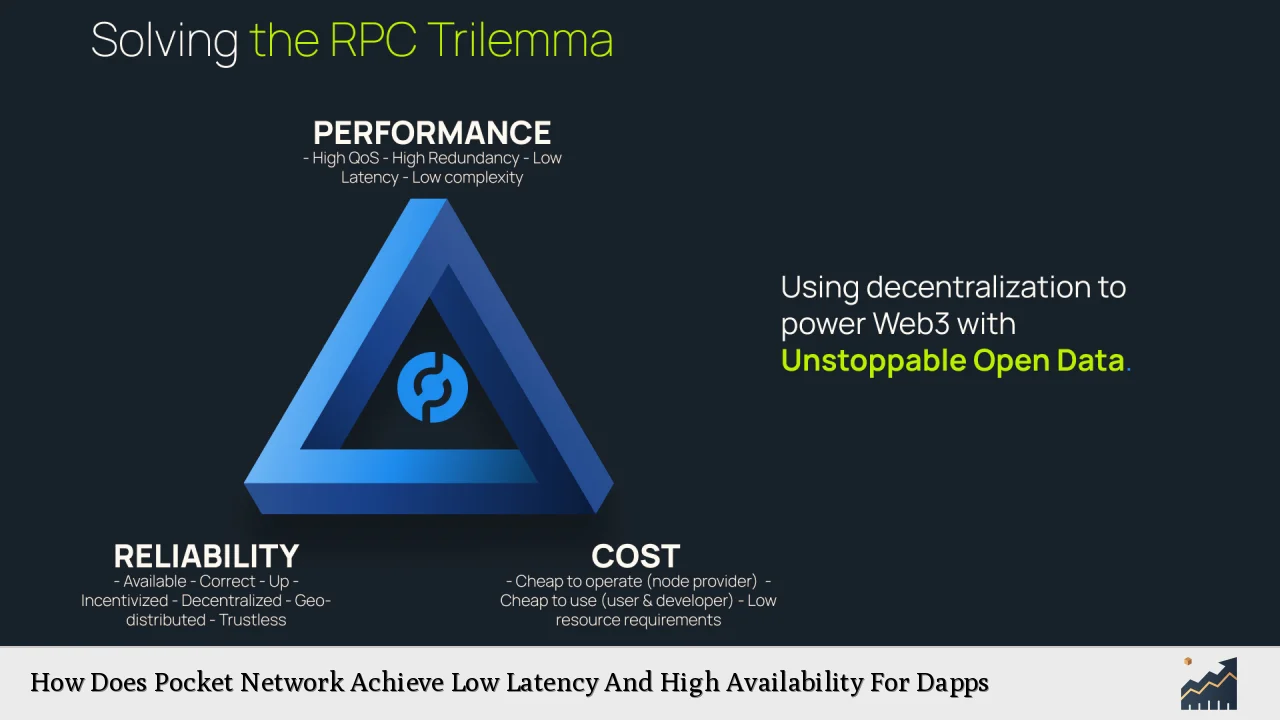Pocket Network is a decentralized infrastructure protocol that provides a reliable and efficient means for decentralized applications (dApps) to access blockchain data. By leveraging a global network of nodes, Pocket Network addresses critical issues such as latency and availability, which are essential for the seamless operation of dApps in the rapidly evolving Web3 landscape. This article delves into how Pocket Network achieves low latency and high availability, supported by current market statistics and trends.
| Key Concept | Description/Impact |
|---|---|
| Decentralized Node Infrastructure | The use of thousands of distributed nodes globally reduces latency by processing requests closer to their origin. |
| Load Balancing | Distributing transaction processing across multiple nodes enhances throughput and reduces the risk of bottlenecks. |
| Incentivization Model | Node operators are rewarded with POKT tokens, ensuring a robust and sustainable network of contributors. |
| Scalability | The architecture allows for horizontal scaling, accommodating increased traffic without compromising performance. |
| High Availability | Pocket Network boasts 99.9% uptime, ensuring that dApps remain accessible at all times. |
| Cost-Effectiveness | The pay-as-you-go model allows developers to scale their usage according to demand without upfront costs. |
Market Analysis and Trends
The demand for decentralized applications has surged, driven by the increasing adoption of blockchain technology across various sectors. As of late 2024, Pocket Network supports over 50 blockchains and has processed billions of relays, indicating a robust growth trajectory. The network recently reported a staggering 14x increase in protocol revenue within 90 days, underscoring its rising importance in the Web3 ecosystem.
Key trends include:
- Increased dApp Adoption: With more developers opting for decentralized solutions, the need for reliable infrastructure has become paramount.
- Focus on Decentralization: The centralization of RPC services has been a significant concern; Pocket Network offers a decentralized alternative that mitigates these risks.
- Growing Investment: The market capitalization of Pocket Network (POKT) has seen fluctuations but remains significant, reflecting investor confidence in its long-term viability.
Implementation Strategies
Pocket Network employs several strategies to ensure low latency and high availability:
- Global Node Distribution: By utilizing a vast network of nodes located around the world, Pocket Network minimizes the distance data must travel, significantly reducing latency.
- Parallel Processing: The architecture allows multiple transactions to be processed simultaneously across different nodes, enhancing throughput during peak usage times.
- Dynamic Load Balancing: The system intelligently distributes requests among available nodes based on their current load, preventing any single node from becoming overwhelmed.
- Developer-Friendly Integration: Pocket Network provides comprehensive SDKs and documentation, enabling developers to integrate its services with minimal technical hurdles.
Risk Considerations
While Pocket Network presents numerous advantages, potential risks include:
- Network Security: As with any decentralized system, vulnerabilities may arise from poorly managed nodes or malicious actors attempting to disrupt services.
- Market Volatility: The value of POKT tokens can fluctuate significantly, affecting the economic incentives for node operators.
- Regulatory Risks: As blockchain technology evolves, regulatory scrutiny may increase, potentially impacting operations or requiring compliance adjustments.
Regulatory Aspects
The regulatory landscape for blockchain and cryptocurrencies is continually evolving. Pocket Network operates within this framework by:
- Adhering to Compliance Standards: Ensuring that its operations align with existing regulations helps mitigate legal risks.
- Engaging with Regulatory Bodies: Proactively communicating with regulators can foster a better understanding of decentralized technologies and their implications.
Future Outlook
Looking ahead, Pocket Network is poised for significant growth as it continues to refine its infrastructure and expand its user base. Key factors influencing its future include:
- Technological Advancements: Ongoing improvements in blockchain technology will likely enhance the capabilities of Pocket Network.
- Increased Demand for Decentralized Solutions: As more businesses recognize the benefits of decentralization, demand for reliable infrastructure like Pocket Network is expected to rise.
- Expansion into New Markets: By supporting additional blockchains and enhancing service offerings, Pocket Network can attract a broader range of developers and applications.
Frequently Asked Questions About How Does Pocket Network Achieve Low Latency And High Availability For Dapps
- What is Pocket Network?
Pocket Network is a decentralized infrastructure protocol that connects dApps with blockchain data through a global network of nodes. - How does Pocket Network reduce latency?
By distributing nodes globally and processing requests closer to their origin, reducing the time it takes for data to travel. - What are the benefits of using Pocket Network for developers?
Developers benefit from reliable access to blockchain data, reduced costs through pay-as-you-go pricing, and high availability. - How does Pocket Network ensure high availability?
The network boasts 99.9% uptime through its decentralized architecture that eliminates single points of failure. - What role do POKT tokens play in the ecosystem?
POKT tokens incentivize node operators to maintain network performance by rewarding them for processing relays. - Is there any risk involved in using Pocket Network?
Potential risks include network security vulnerabilities and market volatility affecting token value. - What is the future outlook for Pocket Network?
The future looks promising due to increasing demand for decentralized solutions and ongoing technological advancements. - How can developers integrate with Pocket Network?
Pocket provides SDKs and documentation to facilitate easy integration into existing dApps.
Pocket Network stands at the forefront of addressing critical challenges faced by dApps in terms of latency and availability. Its innovative approach not only enhances performance but also aligns with the growing demand for decentralized solutions in an increasingly digital world.

